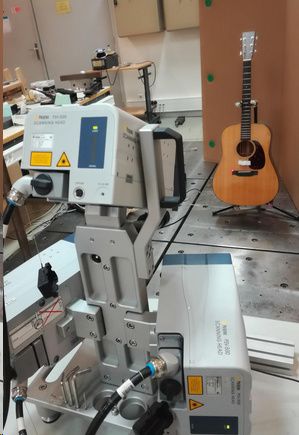Here is a demo:
Overall:
Rechargeable Li-ion Battery operated
Compact size
Mute footswitch
Samples/song stored on micro-SD card
One rotary encoder + switch for menu editing
3 regular pots
1 footswitch
+ external 3 footswitch pedal
1 OLED display
IR convolution with a custom made acoustic IR for my HD-28.
Guitar:
1) High pass filter on IR path (Frequency tunable in the menu)
2) Full PEQ on IR path (Frequency, Gain, Q-factor tunable in the menu)
3) Semi PEQ on IR path (Frequency, Gain tunable in the menu)
4) IR Blend (analog pot always at hand)
5) Volume (analog pot always at hand)
Microphone:
1) 12V Phantom power
2) Quality analog gain circuit with +/-12v voltage rails
3) Gain pot (always at hand)
4) High pass filter (Frequency tunable in the menu)
5) Volume (tunable in the menu)
Rythm/Sample track (Dozen song on SD card right now)
1) External digitech FS3X controlable
2) Track A: looping a cajon beat with shakers and percussion
3) Track B: looping a Drum beat with congas
4) Track C: looping a twice long sample. Can be trigged before or after the beat, it will start sync'd.
5) Count in (setup in menu).
6) Volume (tunable in menu)
The workflow is the following
You have 4 footswitches
* Axoloti main: (n°1)
* FS3X called: Mode/Down/Up
When n°1 is in play
Mode: Play/Stop tracks A+B (B is usually muted)
NB: only first press on Play includes a "count in", so you can use Play/Stop to make breaks
Down: Unmutes Track B to add a drum beat
Up: Launches the sample.
NB: if the footswitch is pressed before the beat. Axoloti wait for the beat to play the sample in sync then loop it until another footswitch press.
If the footswitch is pressed slightly after the beat, the sample is not played from the beginning. It calculate how late you are and play the sample as if you pressed "on-time".
When n°1 is in mute
Mode: Trig the "count in", so the next "Play press" includes a count in.
Down: Browses the song list down
Up: Browses the song list up
CukiIR19Rythm13B.axp (105.3 KB)

 I guess I didn't read the patents well enough. It's interesting with the hammer technique. I wonder if it would be nice to place a small speaker to play a loud pop inside the guitar cavity - I think it's an unfair comparison they make. They bang the strings with a hammer and use EQ to approximate the sound of the acoustic guitar, then they make an impulse response by strumming the guitar. I think the loud pop would be good too, but who knows.
I guess I didn't read the patents well enough. It's interesting with the hammer technique. I wonder if it would be nice to place a small speaker to play a loud pop inside the guitar cavity - I think it's an unfair comparison they make. They bang the strings with a hammer and use EQ to approximate the sound of the acoustic guitar, then they make an impulse response by strumming the guitar. I think the loud pop would be good too, but who knows.